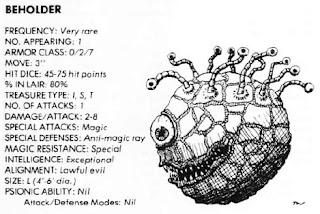

This is represented in game by its lair actions which can cause surfaces to become slimy, difficult terrain, the grasping appendages it can sprout from the wall, and its ability to fire eye rays from magical eyes appearing on the wall. When a Beholder sleeps, the area around it and its lair are warped to mimic its dreams, altering the very fabric of reality itself. Something which is not as well known about Beholders is that they are capable of altering reality with their dreams. This is extremely crippling to mages or anyone relying on any of the great DnD 5e magic items, although its worth noting that this cone of anti-magic suppresses even its own other eye beams. Additionally, the Beholder's larger central eye constantly creates an area of anti-magic in a 150 foot cone in the direction he faces. Although some of these effects are worse than others, none are pleasant, and all can easily result in the death of an unprepared or underleveled player. When the Beholder fires its eye ray, it produces one random effect from this list: charm, paralysis, fear, slow, enervation, telekinesis, sleep, petrification, disintegration, and death. The Beholder's eye beams are by far its most recognizable powers, and each eye has a different effect. RELATED: Dungeons and Dragons 5e Monster Spotlight: The Mind Flayer Most adventurers know that these eye stalks are capable of shooting laser beams, each to a different effect, but not many know about the other bizarre things Beholders can do and how they can be utilized to the greatest effect in a campaign. This creature is a floating mass of flesh, with one distinct, large eye on the center of the ball and several eyestalks protruding as well. The 1975 book Greyhawk introduced the Beholder, and it has been a staple in the Dungeons and Dragons vocabulary ever since. But knowing is half the battle, so here's everything tabletop fans should know about the Beholder, including its intricases, nuances, and even how they might be used in a campaign to make combat encounters more compelling in 5e.įor those that don't know, the Beholder has been a monster in Dungeons and Dragonsalmost since the very beginning. The lore behind the Beholder is actually quite expansive, and there is much more that most players and even dungeon masters don't know about these monsters. Their large eye and several eye stalks are easily recognizable by even the most novice adventurers and have brought ruin to many. These creatures are deranged aberrations capable of incredible, reality-bending feats.

these are just the most powerful ones a DM might throw at a party.In Dungeons and Dragons, there are many fearsome and bizarre monsters, but few are more widely known and avoided than the Beholder. D&D features some of the biggest and nastiest monsters ever conceived in the realm of fantasy.
#Dungeons and dragons beholder types manual
If it terrorized people back in ancient Greece, it's probably in the Monster Manual and if it has been dreamed up and rests in the public domain, you might stumble upon it at one time or another. As any player will tell you, the game features pretty much any and every monster you can think of.

Usually, these gigantic monsters are the ones you get to after an incredibly long quest, but every now and again, a mini-boss of sorts shows up to terrorize even the most advanced of players.įor those nights sitting around a table throwing dice and playing with your pals, it would be wise to learn which monsters in D&D are the most threatening. In most cases, a Dungeon Master might throw one or two big creatures at a party, but for those DM's who have a party who is more annoying than they are entertaining, it might be high time to peruse the Monster Manual and throw something truly big at them. After all, the name of the game has the word "Dragons" in it so you know there are some serious threats lurking around every corner. If there's one thing Dungeons & Dragons is known for, it's monsters.


 0 kommentar(er)
0 kommentar(er)
